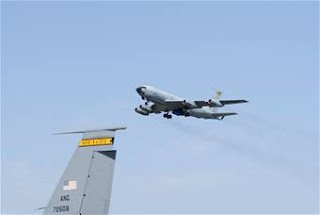
The new commander of the 5th Bomb Wing at Minot, Colonel Joel Westa (USAF photo).
As of tomorrow, Colonel Joel Westa will have one of the toughest–if not the toughest–jobs in the Air Force.
In a ceremony at Minot AFB on Thursday, Westa will take command of the troubled 5th Bomb Wing. The B-52 unit recently lost its certification for handling nuclear weapons after an errant flight on 29 August flight, when one of the giant bombers mistakenly ferried six nuclear-tipped cruise missiles to Barksdale AFB, Louisiana. A six-week Air Force investigation found serious problems in weapons handling and safety protocols.
As a result of the incident–described as the worst breach of nuclear weapons procedures in 40 years–the Air Force fired the 5th Bomb Wing Commander, Colonel Bruce Emig, along with the maintenance group commander and a munitions maintenance squadron commander. The service also dismissed the commander of the 2nd Operations Group at Barksdale. The aircraft and crew involved in the transfer were assigned to the Louisiana base.
At Minot, Colonel Westa takes over for Colonel Paul G. Bell, who had served as acting wing commander following Emig’s dismissal. Bell will continue to serve as the 5th Bomb Wing Vice-Commander, a post he has held since July 2006.
Colonel Westa is also a career bomber pilot, most recently assigned as Vice-Commander of the 36th Wing, located at Andersen AFB, Guam. That wing serves as a host unit for CONUS-based aircraft, including heavy bombers, that deploy to the central Pacific region. A key installation for bomber operations during the Vietnam War, Andersen remains significant as a forward operating base, given its proximity to hotspots in northeast Asia and the South China Sea.
While the command transition at Minot was hardly unexpected, Air Force public affairs handled it in a clumsy manner. When Colonel Bell took over for Emig barely 10 days ago, information provided to the press suggested that he might remain in the job for an extended period, perhaps permanently. Stories from the Associated Press and Minot Daily News, based on accounts from the Minot PA office, did not identify Colonel Bell as an “acting” or “interim” Wing Commander, indicating that he might be Emig’s permanent replacement.
Confusion over Bell’s assignment status was the result of two factors. First, most members of the media don’t understand the mechanics of replacing a wing commander who is suddenly relieved of his/her duties. Until a new commander can be assigned, the deputy or vice moves up and runs the unit on a temporary basis.
However, the Minot PA shop didn’t help matters by taking a heads down/circle-the-wagons approach during the recent controversy. We contacted them after it became known that Colonel Emig had lost his job, and the Minot Public Affairs Office referred us to their counterparts at Air Combat Command. A spokesman at ACC expressed surprise at that move. “It’s their wing commander,” he told us, “Minot should know and they should put out the statement, not us.”
As for Colonel Westa, he faces the dual tasks of getting Minot re-certified in its nuclear mission, and restoring scores of airmen to PRP status, which clears personnel to work with (or around) nuclear weapons. Since late August, more than 65 airmen of varying ranks–Lieutenant Colonel and below–have lost their PRP certification; most of them are reportedly assigned at Minot.
Air Force spokesmen have emphasized that there is no set “timetable” for re-certifying personnel or the bomb wing’s nuclear mission. However, a couple of things seem certain. First, the timeline will be relatively short, due to mission constraints. Minot’s bombers (and crews) are needed to support the nation’s nuclear mission; until the 5th Wing can be recertified, other units will have to shoulder the load, and there are certain capabilities that can’t be replicated outside the B-52 community.
There’s also the matter of continuing the retirement of advanced cruise missiles–the weapons at the center of the Minot debacle. Until the wing is re-certified, Minot cannot send any additional cruise missiles to Barksdale for decommissioning. In theory, the 2nd Bomb Wing could send aircraft and ground crews to Minot and handle the job, but that would be an expensive proposition. The Air Force would prefer to see the 5th Bomb Wing get back on its feet, and resume its role in the transfer and retirement process.
Finally, the repair job at Minot will be carefully monitored, with absolutely no tolerance for pencil-whipping or cutting corners. The Air Force investigation found “an erosion of adherence to weapons-handling procedures at Minot” (no kidding), so the re-certification of personnel and the wing will be done strictly by the book. And, once the job is finished, look for Minot to get a visit from the ACC Inspector General Team undergo a nuclear surety inspection (NSI) as well.
Despite the absence of an official timeline, we’re guessing that Colonel Westa will be given no more than six months to fix the 5th Wing and get ready for inspections. In today’s operational environment, that’s all the time the Air Force can give him.
We’ve said it before, and it bears repeating: This will be a very busy winter at Minot.


